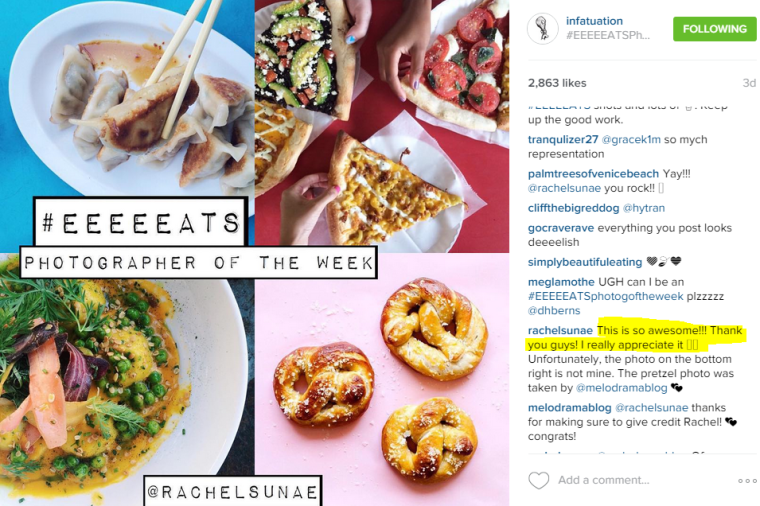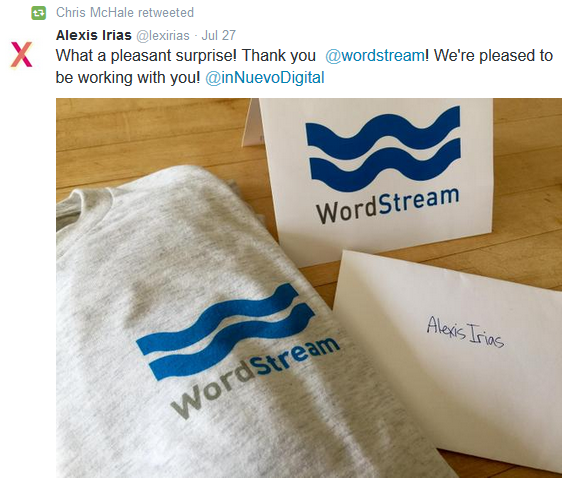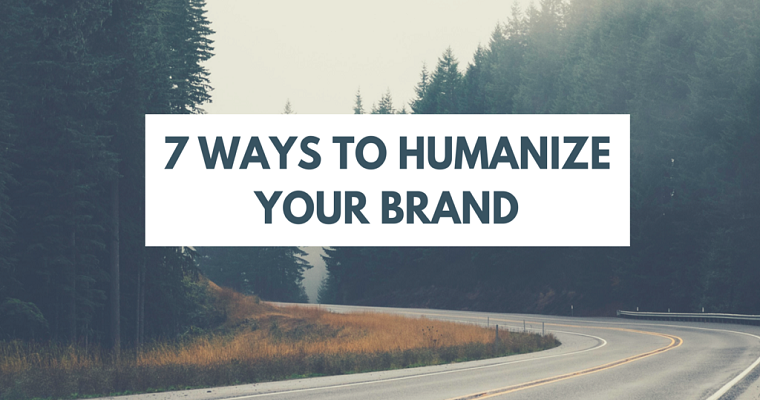Humans connect to, relate to, and trust other humans.
If someone doesn’t trust you, would they be likely to do business with you? Of course not. This is why providing faces and names to demonstrate your brand goes far beyond a money-making machine is immensely critical. Some businesses excel at tying their brand back to the people behind it, making it relatable and memorable to the audience.
But others restrict themselves to a faceless, cold, and corporate environment where one monotone branded voice is utilized across all channels. Scary…
Take a second to think about your favorite brands. Which ones stand out? For me, Rent the Runway, Charity Water, Wistia, and HubSpot instantly come to mind, and unsurprisingly, these are all brands that have mastered the art of humanization.
Yes, some industries are easier to market; for instance, retailers and charitable foundations might have an easier time humanizing their brand than software or insurance companies, yet companies like HubSpot prove that humanizing a brand that might otherwise seem boring is indeed possible.
Brands are made by humans, so why do we sometimes feel like the marketing messages being delivered are robotic? The different between marketing we listen to and marketing that is easily forgettable is the ability to create a relatable and humanized brand to spark a connection between our audiences.
As marketers, you’re trying to gain traffic, generate qualified leads, nurture those leads into customers, retain those customers, and grow revenue, but take yourself out of that money-making mindset for a moment. How do you feel when you browse your company’s site? What about on social media channels and email marketing campaigns? Are all the messages you’re sending out purely promotional? Did you ever stop to think that your brand could be 50X more successful if you stopped pushing solely sales-heavy content and started marketing as a REAL PERSON?
By now, hopefully, I’ve convinced you that humanizing your brand is crucial to long-term business growth. Here are seven ways to show your audiences the shining personalities behind your brand.
#1: Show Off Your Staff
Recruit some office personalities to use in your marketing efforts. Showing the real people behind the work helps build trust with potential customers and also helps increase the likelihood of a client staying on. Physically seeing that there is a team behind the brand is impactful in itself. Follow these tips to get started.
Use REAL Photos of REAL People Who Work at Your Company
That’s right, stock photos won’t do the trick. If you’re an awful photographer, but don’t have the budget to hire one, then recruit someone internally. Chances are there is someone at your company who has at least mastered the art of iPhone photography.
Show off your employees on various parts of your site, like your About Us and Careers pages. Make it clear who writes each piece of content, and include an image of the author. Share albums on your company Facebook page from outings, events, or even just funny moments in the office. Create an Instagram hashtag where you show off day-to-day office moments.
The possibilities to model your fine-looking employees to the public are endless. Hubspot consistently does this well. Even their homepage shows a picture of employees at work. Take a look at their about section below, which shows a quality video of the office space while telling HubSpot’s compelling story.
“One of the unique things about HubSpot, are the people behind it and the people behind our company,” says co-founder & CEO, Brian Halligan. They’ve nailed the ability to turn a somewhat boring industry into a relatable and compelling story that attracts a wide audience of non-churning customers.

Show the Funny and Relatable Side of Your Staff Members
The goal here is to show the world that your company isn’t composed off a bunch of stiff, corporate, Donald Trump look-a-likes, but rather relatable, funny, intelligent individuals who are there to help you rather than take your money.
Check out Quinn Popcorns team page where they show of their staff in mini videos with humorous facial expressions, showing the interesting people behind the pop!

#2: Turn Employees into Brand Promoters
We live in a social media world. The majority of your employees likely have active LinkedIn, Twitter, Facebook, and perhaps even Periscope accounts. This means they have connections, whether it be friends, family, or complete strangers. You should be leveraging your employee’s networks to spread the word about your brand, and show that your employees are proud to represent and serve as the faces of your company.

Of course, this can also be dangerous. Let’s say one of your employees has very strong political or religious views, and you’d rather have your company’s brand steer clear of these controversial matters. To avoid any conflict I’d recommend creating employee guidelines when posting about the brand. With the First Amendment and all, you can’t take away freedom of speech, but you may want to encourage employees to include a blurb that their views do not necessarily reflect their employers (see the example below).

Not every employee will feel comfortable serving as a brand promoter, and that’s OK, but sending out emails encouraging employees to share certain content about the company, or even forming a thought-leadership team can help humanize your brand in a very positive and impactful way.
#3: Hire a Social/Community Manager (or Team)
The brands that tend to excel at humanizing are the ones with a dedicated employee or team working collaboratively to build that component of the company. The person should be someone who’s able to listen, engage, and react. Someone who’s creative and social, a natural problem-solver, with the passion for helping people would be the ideal candidate. Some responsibilities would include…
Running Local Events
For instance, the Startup Institute has a community manager who runs regular events, one of which I recently attended. They partnered with a nearby rock-climbing facility to create an event called “Ladies Night”. Attendees came to hear from some young female entrepreneurs and after we were able to climb for a discounted rate. This is a great way to expose your brand to a wider audience in a fun and interactive manner, and show that your company is involved in the local community.

Create an Online Community
Chances are, not all of your customers will be local. Luckily, creating an online community can drastically increase the human factor of a brand, as this fosters a place for leads, customers, and employees to engage, chat, and bond online.
You can even create these communities through social media. For instance, the restaurant review site Infatuation created an online community by making the hashtag #EEEEEATS a widespread trend for tagging food pictures on social media.
Utilize User-Generated Content
This not only humanizes your brand, but it gets your customers excited. Can you image what it would be like to be featured on a Nike ad for instance? Infatuation does this with their #EEEEEATS hashtag by showing #EEEEEATS of the week, where they pick the best food pictures of the week and feature the photographer on their social accounts.

#4: Personalize Your Automated Marketing
In order to truly humanize your brand, you need to ensure that every touchpoint you have with a lead or customer is somewhat personalized. Whether it’s using the person’s name in an email or utilizing direct language like “you” rather than “we” or “I”.
Implement remarketing tactics with personalized messaging. Automate strategies to send out nurture emails depending on where your leads are within the funnel. If they’re just in the learning stage, send non-promotional, helpful content that is in line with what they previously viewed or searched for. Nowadays there are so many automated ways you can create a personal experience for your audience.
At MozCon in Seattle, I had the pleasure of learning about personalized marketing from Optimizely’s Cara Harshman, who shared a great example of personalized marketing done well. She was redecorating her apartment and found the perfect acrylic media console on CB2.
Weighing her options, she decided to shop around on Craigslist and other e-commerce sites to see if she was missing any potential opportunities for a better deal. A week later, she received a message in her inbox from CB2 with a picture of the same media console and the subject line “Still Deciding?” And, indeed Cara was still deciding, but that email reminder fueled her to take the plunge and buy the piece. Cara gushed about how she felt like CB2 was reading her mind, and really paying attention to her needs.

Connecting on a personal level will truly make your audience feel the human elements of your brand.
“Build trust by creating a strong emotional connection and appealing to people’s sense of self,” says Janet Choi, Chief Creative Officer at iDoneThis. “Remember, they long to be confident and awesome while wanting you to be warm and trustworthy.”
#5: Send Swag & Welcome/Appreciation Letters to New & Loyal Customers
Depending on your business, it might not be feasible to send a gift to every new customer. For example, if you’re a retailer this might not make sense (especially if you sell, say, diamonds), but there are things you can do to show your appreciation like sending a personalized thank-you letter and special offer to regular buyers. For B2B companies with longer sales cycles, contracts, etc., one great technique is to create a personalized onboarding experience by sending out a letter from their dedicated account manager welcoming them to “the family” – it can’t get much more personal than that.
We recently started sending out welcome postcards and T-shirts at WordStream, and man oh man do our clients love it. Just take a look at the example below showing some of the Twitter love we’ve received recently.

#6: Write with Personality
Have you ever read a blog post that lulls you to sleep? Probably not, because you likely abandoned the page after the first few sentences. This is what happens if you write in a monotone, stuffy voice filled with “big words” that are not inviting and easy to digest. Your readers can tell when you’re trying too hard to sound smart, and they’re not interested in your fancy jargon.
“Business and industry-specific jargon is just another way of talking over people’s heads, and although you think you sound super smart and important, you’re really just coming off as inaccessible,” says HubSpot’s Corey Eridon.
All of your site content should be infused with personality – wit, humor, emotion – these are all added pluses. These personality-infused posts will vary depending on each writing style of your content producers and contributors, and that’s ok! Your brand doesn’t need to stick to one voice. Ensure the copy on your homepage is not generic – if another company could easily think of the sage tagline, then ditch it. Be unique with your copy.
I once worked for a company where the first task I was assigned was to write a blog post. I composed this post littered with my personality. To my surprise, my personality was not welcome. The post went through rounds and rounds of edits until it was finalized as a monotone piece. What a shame! Shockingly, this company never gained a massive readership.
#7: Tell Stories of Failure
Your audience is going to relate far more when you share your failures over your successes. That doesn’t mean revealing all of the bugs in your software or talking about the storefront manager’s weekly tardiness and lack of motivation. Don’t air out your dirty laundry, but rather share personal stories or life lessons learned. Share with your blog readers stories of overcoming failure or share stories of how your business helped a customer overcome failure.
Check out this post on medium.com titled, “How quitting my corporate job for my startup dream f*cked my life up.” According to BuzzSumo data, this post was shared 14.4K times since it was published in September of 2014.
Don’t shy away from yourself. You’re going to gain a lot more loyal customers if you infuse your brand with human elements.
Image Credits
Featured Image: Image by Margot da Cunha
All screenshots by Margot da Cunha. Taken August 2015.





